Is my computer too old, how can I
tell if my system is a good candidate for an upgrade?
In my opinion anything older than 2002 year models
may not be good upgrade candidates unless it was a high end system at
the time.
I'm thinking at least pentium 4 processor or AMD
comparable. Most systems from that generation came with 256mb or 512mb
of ram. When we install the maximum (usually 1024mb or 1GB) or more and
reconfigure (tuneup) the operating system and other software the
computer really picks up the speed and ease of use.
This isn't to say that depending on the role of
the computer anything older than 2002 shouldn't be considered. A lot of
small businesses that only need to run simple point of sale programs,
accounting, and word processing can get plenty of use out of older
computers. I work on systems like this all the time. Unless a major
component like a motherboard fails, we keep them going.
Take a look at my instructions
below to see how you can find out right now how much ram you have in
your system and how much of a load you're running.
Why should you upgrade your
current system instead of just buying a new computer?
Most of the stores will sell systems with less
memory installed because they have to compete with lower prices. Chances
are your computer is not equipped with the full amount of memory (ram)
it was designed for to begin with.
Like most of the systems we see these days your
computer is probably not setup to run efficiently. Do you drive around
with your emergency brake on and carry a ton of bricks in the trunk at
all times?
Do you leave all the lights on at your house 24 hours a day just for the
sake of convenience?
This is a waste of your Money, your Energy and your Time. But
unfortunately that's how things are running inside most systems.
You would be surprised to find just how well your
current computer will work for YOU once you take the unnecessary load
off. After all whose computer is it anyway?
It's a Win-Win situation.
Once you increase the computers capacity for work
and decrease the unnecessary background load you will be getting more of
your tasks done, and in less time.
OK let's see how much ram you
have now.
This will work in windows vista as well as windows
xp.
On your keyboard Press and hold the Windows key,
then Press the Pause/Break key to bring up the System Properties.
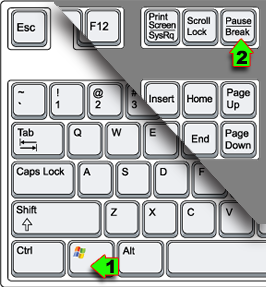
Some keyboards have two windows keys, some only
have one next to the ctrl key on the bottom left as shown above.
If you're running windows xp you will see
something like this, scroll down further for Vista.
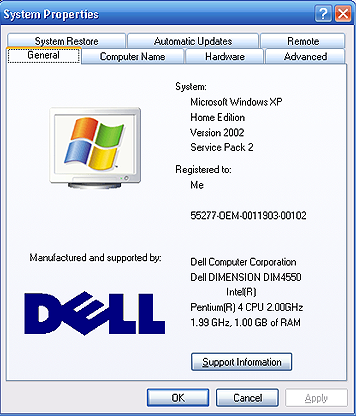
A little closer
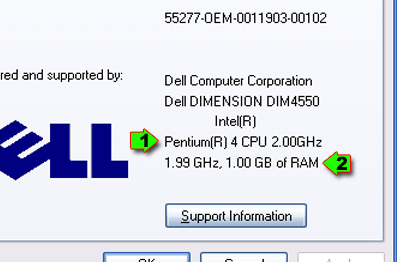
1. A pentium 4 processor running at 2GHz.
2. 1GB of ram
This system was new back in 2002, it originally
had only 256mb of ram but now it's been upgraded to 1000mb or 1GB, if
you think of it in money terms it's gone from $256 to $1000.
This is roughly speaking in rounded numbers,
manufacturers are fudging in some areas by using larger numbers for
sales descriptions when the actual size is slightly less, but it's not
important right now for the purpose of this explanation.
With the operating system properly tuned and the
additional ram this computer is running good and is still very useful.
Right now I have internet pages open, a heavy duty graphics editing
program, webpage editor and email all running at the same time and it's
only using about half of it's total resources.
Now compare that with this older xp system:
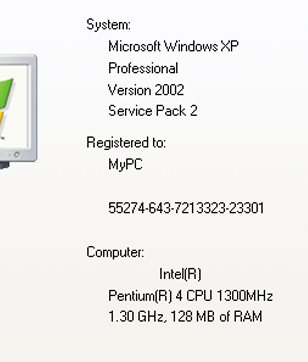
This system was new back in 1999-2000. As you can
see it's in dire need of more RAM. Doing anything more than typing a
letter in a word processor, checking email or viewing a couple websites
is going to bring this one to it's knees fast. Especially if you have
more than one program open at a time. For folks that don't need anything
more this is fine with a little more ram of course.
Ok here's what Vista system properties will
look like:
Press Windows Key + Pause/Break on the keyboard
This is a Dell laptop system from late 2007. This
is a bit of a leap forward from the last two computers.
If you are running Vista and you have less than
the 2GB like the one pictured above then I highly recommend a ram
upgrade. If yours says 64-bit instead of 32-bit then I would go for 4GB
of ram.
You owe it to yourself to always get the most
out of your system...
Now let's check the
current load on your system
Press and hold the Ctrl and Shift
keys, then press the Esc key as shown below
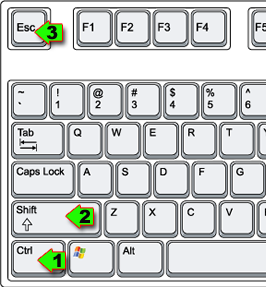
This will open the Task Manager window, the image
below is from Windows XP.
The two most important numbers you want from this
window at this point:
Processes: 35
CPU Usage: 0%
These numbers tell you how hard your computer is
working just standing still.
The higher the number of
Processes means more jobs/tasks are running that take
up your computers time and resources.
The higher the CPU
percentage in use the harder your system is working.
NOTE:
It's ok for your system to work
hard when it's doing what YOU need it to be doing... but if it's working
too hard before you even get started then it's not going to do much for
you!
It's also ok to see the CPU
usage bounce around between 0% and 10% at idle. But if it stays in the
double digits constantly then you are being robbed of the use of your
computer.
The best way to check is right after you bootup
and you haven't opened or started any programs.
Here's a look at a vista machine after boot: